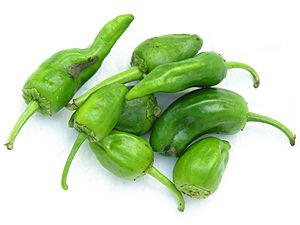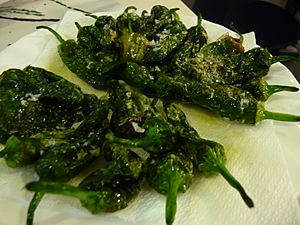Padrón facts for kids
Quick facts for kids
Padrón
|
||
|---|---|---|
 |
||
|
||
| Country | Spain | |
| Autonomous Community | Galicia | |
| Province | A Coruña | |
| Comarca | O Sar | |
| Parroquia |
List
Carcacía
Cruces Herbón Iria Flavia |
|
| Government | ||
| • Type | Concello | |
| Area | ||
| • Total | 48.37 km2 (18.68 sq mi) | |
| Population
(2018)
|
||
| • Total | 8,386 | |
| • Density | 173.372/km2 (449.03/sq mi) | |
| Demonym(s) | Padroneses or Irienses | |
| Time zone | CET (GMT +1) | |
| • Summer (DST) | CEST (GMT +2) | |
| Post code |
15900
|
|
Padrón (Galician pronunciation: [paˈðɾoŋ]) is a town in Galicia, Spain. It is located in the Province of A Coruña. Padrón is a concello, which is the Galician word for a municipality.
The town covers an area of about 48.4 square kilometers. It is 95 kilometers from A Coruña and 23 kilometers from Santiago de Compostela. In 2009, Padrón had a population of 8,968 people.
Padrón is divided into five smaller areas called parishes:
- Carcacía (San Pedro de Carcacía)
- Cruces (Santa María de Cruces)
- Herbón (Santa María de Herbón)
- Iria Flavia (Santa María de Iria Flavia)
- Padrón (Santiago de Padrón)
Contents
History of Padrón
Ancient Roots: Iria Flavia
Padrón has a very old history. It was once a Celtic settlement called Iria Flavia. This ancient town was important because it was located where the Sar and Ulla rivers meet. It was also on key travel routes to other cities like Braga in Portugal and Astorga.
Later, under the Roman Emperor Titus Flavius Vespasianus, it became known as Iria Flavia. For many years, it was an important religious center. However, in the Middle Ages, its main church moved to Santiago de Compostela. This happened after the tomb of Saint James was found there.
Today, Padrón is the last stop on the Portuguese Way, which is a famous walking path for pilgrims going to Santiago de Compostela. The name "Padrón" became more common over time, and "Iria Flavia" is now just a small part of the town.
The Legend of Saint James
A famous story says that Apostle Saint James first preached in Spain in Iria Flavia. After he died, his followers, Theodore and Athanasius, brought his body and head from Jerusalem. They traveled in a stone boat and landed in Iria.
They tied their boat to a large stone, which in Galician is called a pedrón. This is how the town got its name, Padrón. You can still see this legendary stone today in the church of Santiago de Padrón. Saint James's followers then buried him in Compostela.
Growth and Challenges
Because of the legend, Padrón became a popular stop on the Camino de Santiago pilgrimage route. But this also made it a target. In the 10th and 11th centuries, Vikings and Normans attacked the town many times.
To protect the area, the Torres del Oeste (West Towers) were built in Catoira. These towers helped stop the invasions. After this, Padrón had a very successful period in the 12th and 13th centuries.
During this time, a quay (a dock for ships) was built by the Sar river. The first galleys (warships) of the Galician Navy were built there.
In the 15th century, a leader named Archbishop Rodrigo de Luna moved the town council of Santiago de Compostela to Padrón for two years. He did this to reduce the power of the local nobles. His tomb, with a statue, is in the Iria Flavia church. Over time, the nearby city of Compostela became the main focus in Galicia.
Padrón's Economy
The economy of Padrón is mostly based on fishing and agriculture. Farmers here grow peppers, kiwis, and flowers. There are also some other industries like wood production, tanned hide (leather), and aluminum work.
Tourism is also important because Padrón is a historic place on a famous pilgrimage route. Its location at a crossroads also helps with trade.
Population of Padrón
Padrón has seen its population change over the years. In 2018, the town had a population of 8,386 people. The people from Padrón are called Padroneses or Irienses.
Famous Padrón Peppers
Padrón is most famous for its special green peppers, known as pementos de Padrón. These small peppers come from the Capsicum annuum plant family. They are usually served fried with olive oil and coarse salt.
Most of these peppers taste sweet and mild. But some of them can be surprisingly hot and spicy! This is what makes the dish so interesting. A popular saying in Galician goes, "Os pementos de Padrón, uns pican e outros non" which means "Padrón peppers, some are hot and some are not." The level of heat depends on a chemical called capsaicin in each pepper. Peppers grown later in the summer, around August or September, often have more capsaicin than those grown earlier.
About 15,000 kilograms of Padrón peppers are grown each year. Most of them come from the Herbón area, between June and September.
Pepper Festival
Since 1979, Padrón has held a special event called the Festa do Pemento de Padrón. This popular food festival takes place every year on the first Sunday in August. It is held at the Franciscan friary in Herbón.
The Franciscan friars were the ones who first brought pepper seeds from Mexico in the 16th century. They then adapted the peppers to the local soil and Oceanic climate of the valley. They also developed special ways to grow them.
Notable People from Padrón
Padrón has been the home of four important writers:
- Macias the Lover (died 1434), a medieval poet.
- Juan Rodríguez de la Cámara (1390-1450), also known as Juan Rodríguez de Padrón, a medieval writer and poet.
- Rosalía de Castro (1837-1885), a Romantic poet and an early supporter of feminism.
- Camilo José Cela (1916–2002), a famous writer and Nobel Prize winner.
See also
 In Spanish: Padrón (La Coruña) para niños
In Spanish: Padrón (La Coruña) para niños





